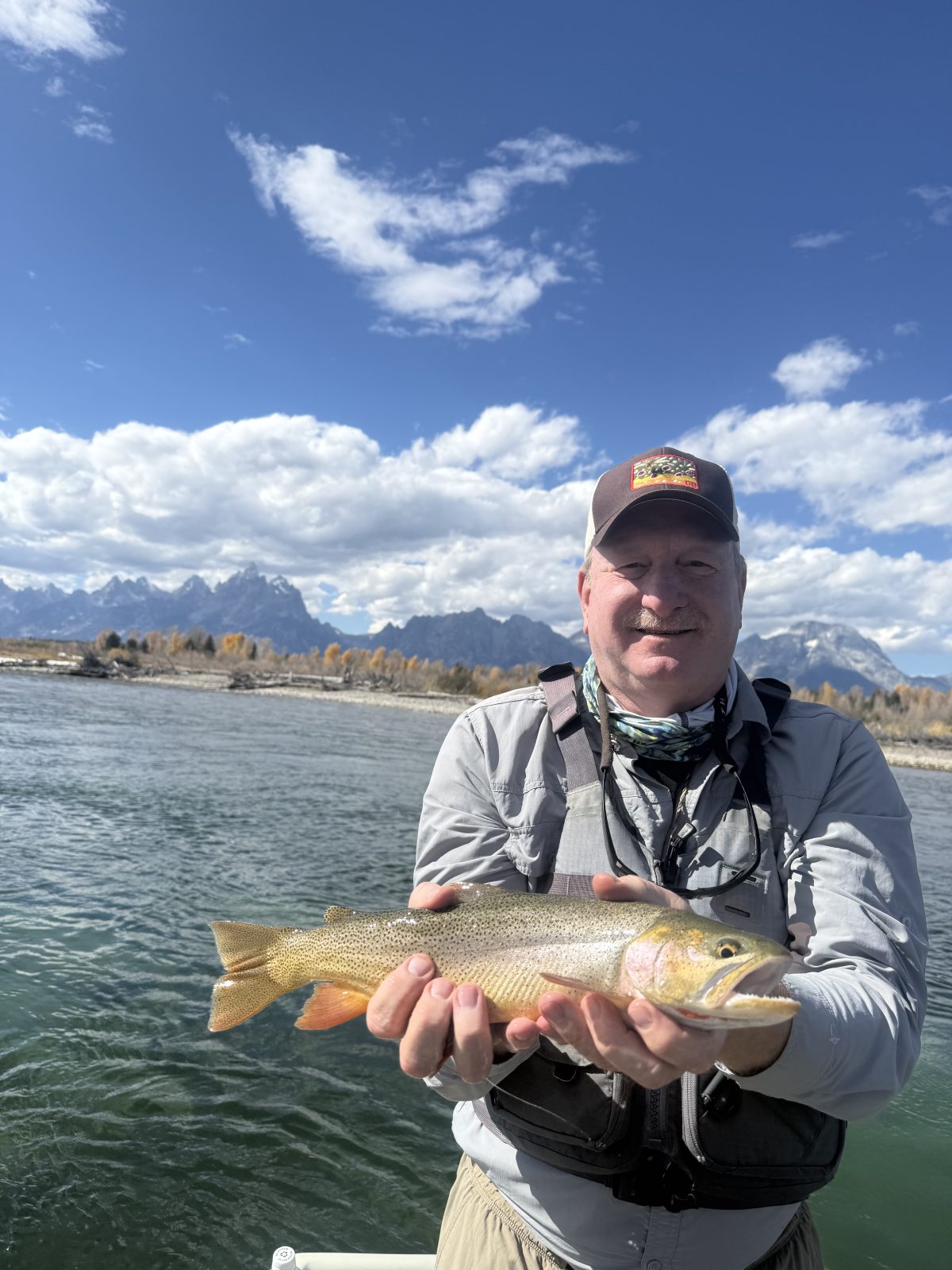
Snake River
After the autumn ramp down from Jackson Lake Dam this past week, flows are now at 280cfs and will be for quite a few months. There are decent hatches of infrequen PMDs and mahogany duns most days and you will probably still see a couple Claassenia stones around from time to time. The best action has been on the middle and lower reaches of the river from Moose Bridge down to Sheep Gulch with riffles, seams, eddies, side channels, confluences, troughs, ledge rock pools, and banks offering consistent action. At the same time, with flows having dropped, there is a fair amount of displacement amongst fish, so being well off of prime holding lies has been producing just as well. Action can start as early as 10am but kicks into gear around 11:30 am and slowing around 4pm. Moderately sized attractors fished with a dropper nymph and tandem dry rigs are working equally well depending on which holding water types one is focusing on.
Streamers are starting to kick back into gear as they usually do this time of year. There is consistency just about everywhere, including banks, structure, riffle pools, ledge rock pools, seams, and confluences. Production can also be throughout the day and, if there is any slower period, it is between 11:30 am and 1:30 pm. Both moderately sized and large patterns are working equally well. Fish these on floating lines or sinking tips in the INT to 6ips range. Vary up your retrieves, but focus on slower line strips in slow to moderate currents and faster ones in fast currents. If fishing double streamers, try and go with at least five feet of separation between each pattern.
South Fork
Flows from Palisades Reservoir stands at approximately 4,700 cfs. Mutant stones have waned, but ther is still decent action with opportunistically feeding trout on all reaches when using moderately sized attractors in a variety of holding water, including banks, structure, parallel drop-offs, troughs, and seams. Infrequent PMDs are emerging intermittently most days, with mahogany duns and BWOs becoming the main fare on cooler, wetter days. This is making riffles, eddies, side channels, troughs, and flats good places to target with tandem rigs composed of a variety of mayfly dun and emerger imitations. October caddis are also beginning to appear slightly on the upper reaches from Spring Creek Bridge down to Wolf Eddy. Action on these is occurring along banks and structure with slow to moderate currents, parallel drop-offs, riffle pools and inside current margins, seams, and eddies.
Streamers are starting to kick into gear again, especially with size. The most productive reaches have been from the Dam down to Conant and from Wolf Eddy down to Menan. Slow to moderate current speeds are outperforming fast water with banks, structure, side channel pools, seam margin, and the inside corner of riffles producing best. Moderately sized patterns are the best way to go. Go with floating lines or sinking tips in the INT to 3ips range and retrieves alternating between slow and moderate.
Flat Creek
Decent surface action occurred during the past week on those days with cloud cover and rain with fish feeding on BWO, PMD, and mahogany patterns, especially emergers. This is still occurring on seams, confluences, eddies, and micro-rifles, although to a lesser degree. More recently there has been better subsurface activity on dragonfly, damsel, and cranefly nymph/larva imitations. These are producing when being swung and then retrieved in an imitative fashion along undercut banks, on seams, and over submerged structure. At times it can be a good ideal suspend cranefly larva and dragonfly patterns with hesitations of a few seconds between 18 to 16 retrievals of line, depending on if you are using pinch retrieves or figure 8/hand-twist retrieves.
Salt River
Low gradient reaches have had a big uptick in action over the past week with the best action, be in on the surface or subsurface with nymphs, occurring along seams and the head of currents in recirculating eddies. #16 – #18 mayfly and midge imitations are producing with the most consistency. There can be action on #12 attractors in the same water, but they are working best along banks and in riffles. If fishing a dry-dropper rig, keep your dropper tippet in the two-foot to three-foot range regard of the depth of water you are fishing.
Yellowstone National Park
Madison River – This is not the strongest surge of browns out of Hebgen, but it is nonetheless a good one. As has been the case over the past couple of weeks, riffles, seams, and troughs are producing well with egg patterns but also with cdc soft hackle nymphs and smaller stonefly nymph imitations. Small to moderately sized streamers are working in the same water but are a producing best in deeper pools on the upper reaches of the Madison.
Yellowstone Lake – Good fishing continues of flats in the morning to early afternoon hours and even better on drop-offs throughout the day and into early evening. Small to moderately sized streamers, and to a lesser degree dragonfly, damsel, and cranefly larva/nymph patterns, fished on hover lines and full sinking intermediate lines are working well. Hanging midge and balanced leech patterns are producing as well as anything else on the edge of drop-offs and on shallow bars.
Lewis Lake – We are finally seeing movement on the part of browns as the stage and begin to make their run up the Channel. Lake trout are also starting to congregate on flats, although there is more activity in deeper water on these flats – six feet to eight feet in depth. For all of these, go primarily with small-ish baitfish imitations (Clousers, Slumpbusters, etc.) on floating lines, hover lines, and sinking tips in the INT to 3ips range. Concentrate on variable retrieves, but resist hesitating your line strips.